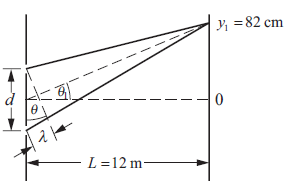
Concept explainers
(a)
The separation of the slits.
(a)
Explanation of Solution
Given:
The
The distance between the slit and screen is
The distance of first interference from the central maxima is
Formula used:
The figure below shows the geometry of the given setup.

Here
Write the expression for two-slit interference maxima for
Rearrange the above expression for the distance between the two slits.
Write the expression for the triangle in the above figure with sides
Calculation:
Substitute
Substitute
Conclusion:
Thus, the separation of the slits is
(b)
The possible number of interference fringes.
(b)
Explanation of Solution
Given:
The wavelength of the light used is
The distance between the slit and screen is
The distance of first interference from the central maxima is
Formula used:
Write the expression for two-slit interference maxima for
Here
Rearrange the above expression for the distance between the two slits.
Write the expression for the triangle in the above figure with sides
Here
Write the expression for the two slit interference maxima.
where
Write the above expression for maximum number of interference fringes, for
Here
Simplify above expression for
Write the expression for the maximum number of fringes in the central maximum.
Here
Calculation:
Substitute
Substitute
Substitute
Substitute
Conclusion:
Thus, the possible number of interference fringes is
Want to see more full solutions like this?
Chapter 33 Solutions
PHYSICS F/SCI.+ENGRS.,STAND.-W/ACCESS
- Hi! I need help with these calculations for part i and part k for a physics Diffraction Lab. We used a slit width 0.4 mm to measure our pattern.arrow_forwardExamine the data and % error values in Data Table 3 where the angular displacement of the simple pendulum decreased but the mass of the pendulum bob and the length of the pendulum remained constant. Describe whether or not your data shows that the period of the pendulum depends on the angular displacement of the pendulum bob, to within a reasonable percent error.arrow_forwardIn addition to the anyalysis of the graph, show mathematically that the slope of that line is 2π/√g . Using the slope of your line calculate the value of g and compare it to 9.8.arrow_forward
- An object is placed 24.1 cm to the left of a diverging lens (f = -6.51 cm). A concave mirror (f= 14.8 cm) is placed 30.2 cm to the right of the lens to form an image of the first image formed by the lens. Find the final image distance, measured relative to the mirror. (b) Is the final image real or virtual? (c) Is the final image upright or inverted with respect to the original object?arrow_forwardConcept Simulation 26.4 provides the option of exploring the ray diagram that applies to this problem. The distance between an object and its image formed by a diverging lens is 5.90 cm. The focal length of the lens is -2.60 cm. Find (a) the image distance and (b) the object distance.arrow_forwardPls help ASAParrow_forward
 University Physics Volume 3PhysicsISBN:9781938168185Author:William Moebs, Jeff SannyPublisher:OpenStax
University Physics Volume 3PhysicsISBN:9781938168185Author:William Moebs, Jeff SannyPublisher:OpenStax Glencoe Physics: Principles and Problems, Student...PhysicsISBN:9780078807213Author:Paul W. ZitzewitzPublisher:Glencoe/McGraw-Hill
Glencoe Physics: Principles and Problems, Student...PhysicsISBN:9780078807213Author:Paul W. ZitzewitzPublisher:Glencoe/McGraw-Hill Physics for Scientists and Engineers: Foundations...PhysicsISBN:9781133939146Author:Katz, Debora M.Publisher:Cengage Learning
Physics for Scientists and Engineers: Foundations...PhysicsISBN:9781133939146Author:Katz, Debora M.Publisher:Cengage Learning
 Principles of Physics: A Calculus-Based TextPhysicsISBN:9781133104261Author:Raymond A. Serway, John W. JewettPublisher:Cengage Learning
Principles of Physics: A Calculus-Based TextPhysicsISBN:9781133104261Author:Raymond A. Serway, John W. JewettPublisher:Cengage Learning College PhysicsPhysicsISBN:9781285737027Author:Raymond A. Serway, Chris VuillePublisher:Cengage Learning
College PhysicsPhysicsISBN:9781285737027Author:Raymond A. Serway, Chris VuillePublisher:Cengage Learning





